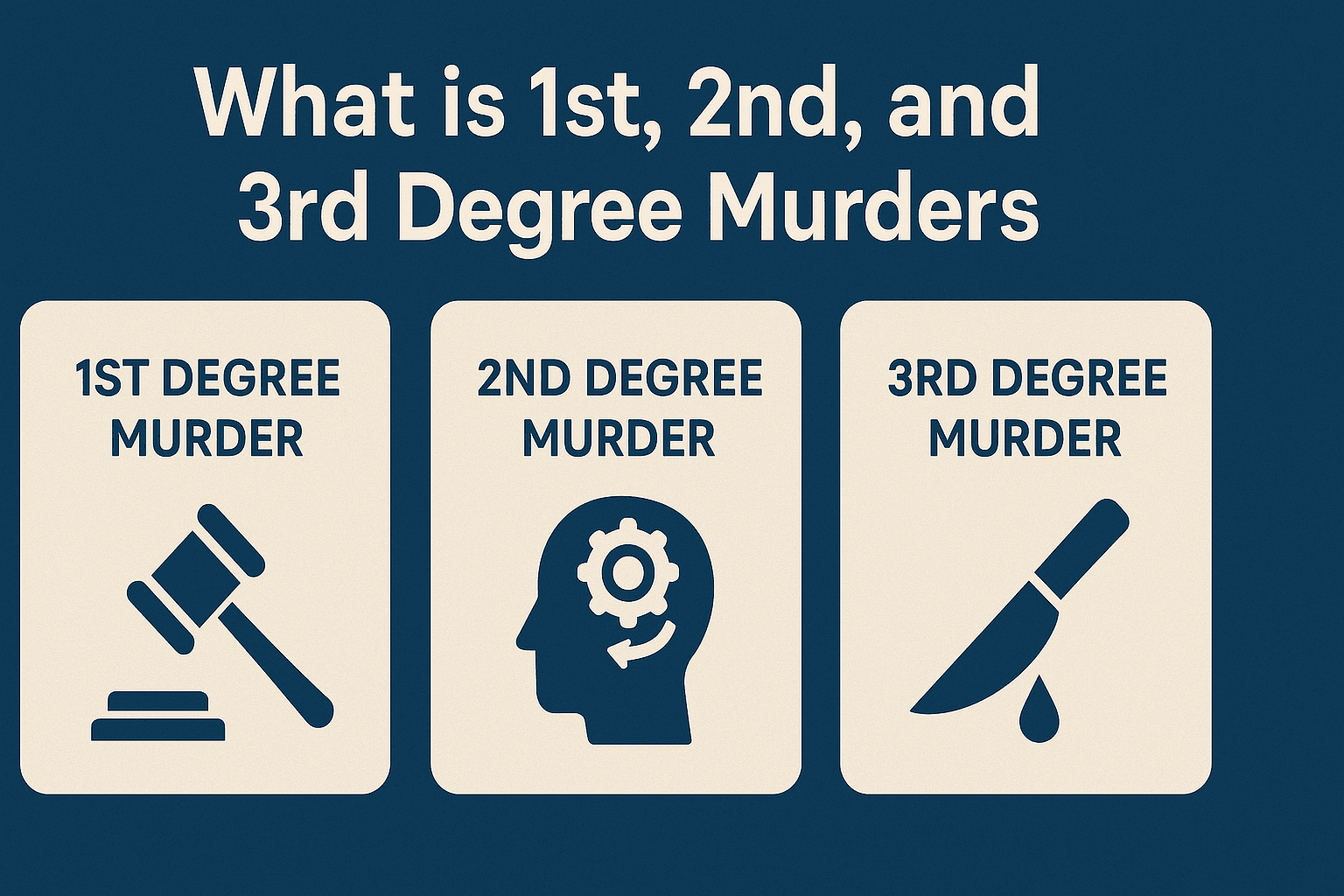What is 1st, 2nd, and 3rd Degree Murders in Australia?
Introduction to Homicide Offences in Australia
In popular media and overseas legal systems, particularly in the United States, homicide is often classified into "first", "second", and "third degree" murder. However, Australian criminal law does not use this terminology. Instead, unlawful killings are grouped under more specific legal classifications, each defined by the accused’s intent, actions, and state of mind.
This article explores these distinctions within the Australian legal framework, providing a clear explanation of how our system treats murder and manslaughter, and what—if anything—would compare to the concept of murder “degrees”. Learn more at AustLII.
Does Australia Use Degrees of Murder?
The short answer is: no. Australia does not categorise murder into degrees. The concept of “degrees” of murder is derived from the U.S. legal system, which is based on a state-by-state classification model. In contrast, Australian states and territories use a unified set of statutory and common law principles to distinguish between murder, manslaughter, and other types of homicide.
How Australian Law Classifies Unlawful Killings
Unlawful killings in Australia fall into three broad categories:
Murder: The intentional or extremely reckless killing of another person.
Manslaughter: Unlawful killing without the intent to kill, often due to negligence or provocation.
Other homicide-related offences: Including infanticide and dangerous driving causing death.
Explore our Homicide Law Guide for more details.
Legal Definition of Murder in Australia
Each Australian jurisdiction has a slightly different formulation, but generally, to be convicted of murder, the prosecution must prove that the accused:
Intended to kill the victim;
Intended to cause grievous bodily harm likely to result in death; or
Acted with reckless indifference to human life.
Under Section 18 of the Crimes Act 1900 (NSW), murder carries a maximum penalty of life imprisonment.
Voluntary and Involuntary Manslaughter
Manslaughter is a separate and less serious offence than murder. It typically involves:
Voluntary manslaughter: Where the offender is found to have been provoked or had diminished responsibility.
Involuntary manslaughter: Where there was no intent to kill, but death occurred due to criminal negligence or during an unlawful act.
Penalties vary greatly but are usually lower than those for murder, reflecting the lower moral culpability.
Comparison with U.S. Degrees of Murder
| U.S. Classification | Australian Equivalent |
|---|---|
| First-degree murder | Murder with premeditation |
| Second-degree murder | Intentional killing without premeditation |
| Third-degree murder | Reckless killing (possible manslaughter in AU) |
What Would Be Considered '1st Degree Murder' in Australia?
In Australia, first-degree murder, as known in the U.S., closely resembles murder with premeditation and intent. Though the term is not used legally, courts consider preplanning as an aggravating factor during sentencing.
The Closest Equivalent to '2nd Degree Murder' in Australia
Second-degree murder in the U.S.—where there is no premeditation but intent exists—is typically still prosecuted as murder under Australian law. Premeditation is not a necessary element for a murder conviction in Australia.
Understanding '3rd Degree Murder' or Reckless Killings
What Americans refer to as third-degree murder, often defined as a death resulting from reckless disregard for life, may be charged as manslaughter or reckless murder in some Australian jurisdictions. The key factor is whether the accused foresaw that their actions were likely to result in death.
Penalties and Sentencing Ranges in Australia
| Offence | Typical Penalty |
|---|---|
| Murder | Up to life imprisonment |
| Manslaughter | Variable (typically 10–25 years max) |
| Infanticide | Up to 5 years (varies by jurisdiction) |
Sentencing depends on numerous factors, including intent, method, prior convictions, and whether the offender pleaded guilty.
Factors Influencing Charges and Sentencing
State laws vary slightly across Australia, but key influencing factors include:
The mental state of the accused at the time
Whether a weapon was used
The vulnerability of the victim
Previous criminal history
Remorse and rehabilitation prospects
Key Case Examples from Australian Jurisprudence
R v Crabbe (1985): Set a precedent for “reckless indifference to life” constituting murder. AustLII
Queen v Lavender (2005): Distinguished involuntary manslaughter from murder based on the absence of intent.
Legal Defences in Homicide Cases
Several defences may be available, depending on the facts:
Self-defence
Mental illness defence
Automatism
Provocation (limited and abolished in some states)
Each defence has specific legal criteria and must be supported by evidence. See our Criminal Defense Guide.
Why Understanding the Distinction Matters
Misunderstanding the term “degrees of murder” in Australia can lead to confusion, especially for those comparing international cases or facing charges. For defendants, the difference between murder and manslaughter can mean the difference between a life sentence and a significantly reduced term.
FAQs About Murder Charges in Australia
No. Australia uses terms like murder and manslaughter without referencing degrees.
Life imprisonment, though not always mandatory depending on the case and state.
Murder requires intent or reckless indifference; manslaughter does not.
In some jurisdictions, provocation may reduce murder to manslaughter.
No. Sentencing laws and maximum penalties vary by state and territory.
You need experienced legal representation to explore valid legal defences and challenge the prosecution's case.
Conclusion: Simplifying Complex Legal Ideas for the Public
While the terms “first, second, and third degree murder” are not part of Australian criminal law, the principles they represent—intent, premeditation, and recklessness—are still highly relevant. Understanding how Australian law classifies and prosecutes unlawful killings helps demystify the legal process and ensures public awareness of these serious offences.
Need Criminal Law Advice? Contact AHL Legal Today
If you’re facing a serious criminal allegation or need clarity on legal definitions and your rights, our dedicated criminal law team at AHL Legal is here to help.
✅ AHL Legal: Your Trusted Legal Partner
We provide expert advice, clear guidance, and strong representation.
👉 Click here to contact AHL Legal for a confidential consultation or call us at 1300 91 66 77.
🌐 Visit our website: www.ahllegal.com



 1300 91 66 77
1300 91 66 77







 HOME
HOME



